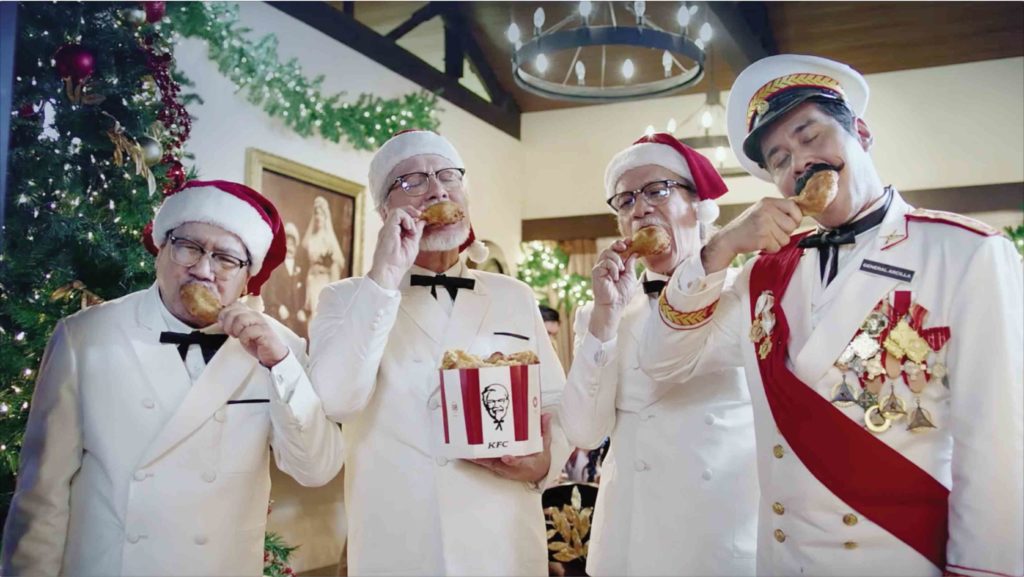The Filipino colonel is coming to town

Filipino Colonels (from left) Martinez, Valdez, Medina and Heneral Arcilla promise to protect KFC’s secret recipe.
When Ronaldo Valdez took to the stage to announce his love for chicken, social media said it guessed correctly the actor would be the Filipino version of Colonel Harland Sanders. Valdez indeed looked the part of the KFC founder: He had an American vibe and a Santa Claus-serene persona right down to his white mustache and goatee.
That was in the latter part of May, when Ogilvy and Mather Philippines, the advertising, marketing and public relations partner of the Kentucky-born brand, revealed on different platforms the “First Filipino Colonel” weeks after teasing the auditions of other Sanders-wannabes Pen Medina and Leo Martinez.
But in July, Medina took over the character, albeit cocky and has the love for all things action including being wrapped in a contraption, barreling down Edsa to promote, among other things, a burrito.
In an interview, Ogilvy managing partner and KFC account chief Caloy Sambrano says the creative team behind the ad campaign realized Filipinos have always thought of Colonel Sanders as a mascot.
Sambrano says it is not easy telling the story of Sanders here because he was, after all, a foreigner, very much unlike the happy bee of the country’s largest fastfood chain.
But if there’s one thing that resonated with Filipinos, it’s their love for fried chicken, he says.
“The challenge was to tell [that story] in an interesting and funny way because Filipinos love humor,” he says.
Instead of reintroducing Colonel Sanders, the creative team decided it was more relevant to make him Filipino, Sambrano says.
“We just used creative license to portray the different sides of the Colonel,” he says.
For one, Sanders—who began perfecting the fried chicken at a service station in Kentucky in the 1930s—had a colorful personality when he was alive. According to a New Yorker article from the 1970s, Sanders himself knew how to play PR, but also had a “terrible wrath” when visiting franchisees that did not meet his gravy standards.
Diverse
Tweaking the image of the person (henceforth called, simply, the Colonel) is not original to the Philippines. In fact, the global fast food giant has introduced different characters across the world including a gold-dipped statue-like coronel to sell a honey mustard-flavored fried chicken called Georgia Gold and a sun-kissed coronel to peddle the extra crispy variant.
The Philippine team, however, knew how to present a culturally attuned image. In October, Martinez was introduced as the resourceful coronel who taught his listeners how to turn a budget meal into a gourmet spectacle.
Then there is John Arcilla, who played the cantankerous Filipino hero Antonio Luna in the movie Heneral Luna.
Arcilla, acting as a Luna-possessed general, wanted to be demoted to coronel so long as he can promote his “favorite” Christmas feast.
Not to worry, KFC did not want to reduce the Filipino hero into a commercial fool. “We got John Arcilla to play ‘Heneral Arcilla’ as a contrast to the colonels and he and his camp agreed to do it,” Sambrano says.
A week after this interview, KFC proclaimed a “hero” coronel in times of emergencies (or when there’s not enough money for fancy food): Albert Martinez in a Superman-like costume.
Humor
“It’s also our strategy to keep people guessing [who’s the next coronel] and renew their love for fried chicken” while making the brand relevant to all consumers and not just millennials, he says.
In the era of hugots (deep-seated emotions), KFC chose humor.
“Should we go the same route just because our competitors are doing it? If the 11 secret herbs and spices is what we’re bannering, or the fried chicken and gravy, that’s not a very serious product, right? So why position the communication to be serious? Why not make it fun? Filipinos love to eat. Filipinos love to share conversations over food. So why can’t our communications be light-hearted and fun at the same time?”
It also helped that KFC as a brand knows how to play—with its food—even to the horror of healthy eating experts. The Philippines branch made international headlines when it introduced a calorie-frenzied hotdog wrapped in fried chicken just a few years back.
“You can’t have campaigns like that without brave clients, without clients who trust you, clients who have been on this journey and at an early stage handing to you their business and giving you their total trust,” Sambrano says.
He says Ogilvy’s culture jived with KFC in that they are both on the same page when it comes to aesthetics and business.
“We focus on creativity and effectiveness. Yes, we are a creative agency, but more and more clients are getting demanding: Does [the campaign] affect sales? What metrics will it move? We approach them as business partners, not just as creative partners,” he says.
But Sambrano maintains no one still knows the secret recipe behind the famous fried chicken—not Ogilvy and not even the actors who have contributed to shaping the Filipino Coronel storyline.
He readily shares, however, the secret formula behind the campaign’s success. “The secret formula: The partnership and trust we have with the client is doing wonders. [The ad team] will always look at an advertising brief as an opportunity, something that can shape culture.”
Asked how many more coronels are there and will a woman be one of them, he says: “As long as it’s working, we want to keep people guessing. It works to our advantage.”
